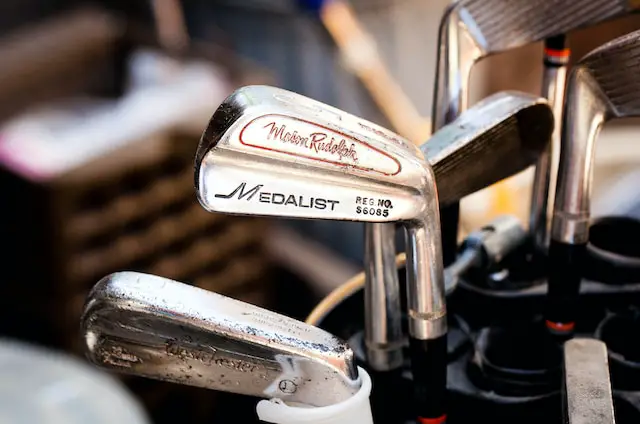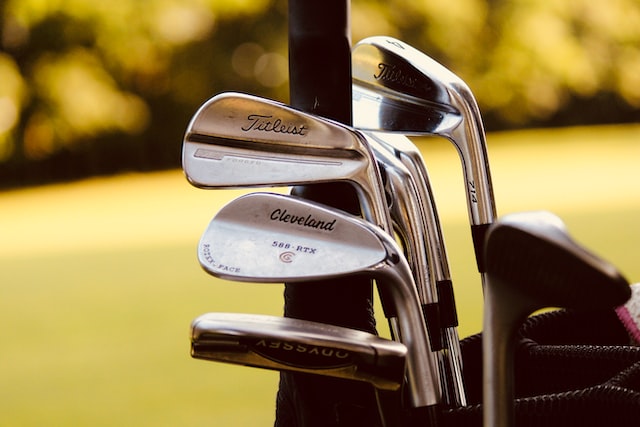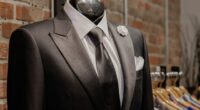The main difference is in the construction of the club head. Blades have a solid piece of metal for the hitting surface, while irons have a cavity in the back that allows for more weight to be distributed around the perimeter of the club head.
What are Irons?
In golf, irons are a type of club used for hitting shots from the fairway or rough onto the green. They are typically numbered from 1 to 9, with lower numbers indicating clubs with less loft and longer shafts for hitting longer shots, and higher numbers indicating clubs with more loft and shorter shafts for hitting shorter shots with more accuracy.
Irons have a flat, angled face with grooves that help grip the ball and create spin for better control. The shafts of irons are typically made of steel or graphite and can be customized to fit a golfer’s swing and preferences.
Each iron in a set has a specific purpose, with the lower-numbered irons (1-3) used for long-distance shots, the middle-numbered irons (4-6) used for mid-range shots, and the higher-numbered irons (7-9) used for shorter, more precise shots onto the green.
Irons are designed to hit the ball with a descending blow, compressing the ball against the clubface and producing backspin to help control the ball’s flight and direction. They require skill and practice to use effectively, but can be a valuable tool for any golfer looking to improve their game.
What are Blades?
In golf, a “blade” is a type of iron club that is designed with a small, compact head and thin clubface. Blades are typically used by more experienced golfers who have a higher level of skill and control over their swings, as they require a high degree of precision to hit accurately.
Blades are sometimes also referred to as “muscle back” irons, as they are often forged from a single piece of metal and have a thin, streamlined profile that resembles the shape of a muscle. The term “blade” comes from the fact that the clubface is very thin, with very little weight behind it, which can make it feel as though the golfer is hitting the ball with a sharp blade.
Blades are popular among better players because they provide a greater degree of control over ball flight and shot shaping. They require a consistent swing and proper ball contact to achieve the desired results, and are often used for shots that require a high degree of accuracy, such as approach shots onto the green or shots from difficult lies in the rough.
While blades can be rewarding to use for skilled golfers, they can also be unforgiving if the golfer does not make solid contact with the ball. This is because the thin clubface and compact head do not provide as much forgiveness as other types of irons, such as cavity back or game improvement irons. As a result, blades are not typically recommended for beginning or intermediate golfers who are still developing their swings and ball-striking abilities.
Which is better for a beginner?
(Photo by Diana Palkevic on Unsplash )

For a beginner, it is generally recommended to start with a set of cavity back irons or game improvement irons, rather than blades. These types of irons have larger clubheads and more forgiving clubfaces, which can help beginner golfers to hit the ball more consistently and with greater ease.
Blades, on the other hand, are typically designed for more experienced golfers who have developed a consistent swing and good ball-striking abilities. They require a higher degree of precision and control to hit accurately, and can be less forgiving of mishits or poor swings.
While blades may offer more control and shot-shaping ability for skilled golfers, they are not generally recommended for beginners who are still learning the basics of the game. Starting with a set of cavity back or game improvement irons can help beginners to develop their swings and ball-striking abilities, and can ultimately lead to greater success and enjoyment on the golf course.
Which is better for a professional?
(Photo by Virgile Donadieu on Unsplash )

Whether a professional golfer should use irons or blades depends on their personal preferences and playing style. Both types of clubs have their advantages and disadvantages, and what works well for one golfer may not work as well for another.
Blades, also known as muscle back irons, are generally designed for more experienced golfers who have a consistent swing and good ball-striking abilities. They offer greater control over ball flight and shot shaping, but require a high degree of precision and consistency to hit accurately. Some professional golfers prefer blades for their superior feel and control, while others may find them too unforgiving for their liking.
Cavity back or game improvement irons, on the other hand, have larger clubheads and more forgiving clubfaces, which can help golfers to hit the ball more consistently and with greater ease. While they may not offer the same level of shot shaping ability as blades, they can be more forgiving of mishits and can help golfers to achieve greater distance and accuracy.
Ultimately, the choice between irons and blades comes down to personal preference and playing style. Some professional golfers may prefer the feel and control of blades, while others may find cavity back or game improvement irons to be more suited to their needs. It is important for each golfer to experiment with different types of clubs and find what works best for their individual game.
Which is better for specific shots?
The type of iron that is better for specific shots can depend on various factors, such as the golfer’s skill level, swing speed, and playing style, as well as the type of shot they are trying to make. However, there are some general guidelines that can be useful for selecting the right type of iron for a specific shot.
For approach shots onto the green, where precision and accuracy are important, many golfers may prefer to use a blade iron. Blades offer greater control over ball flight and shot shaping, and can help golfers to make accurate shots onto the green from a variety of distances and lies.
For shots where distance is the main priority, such as tee shots or fairway shots, cavity back or game improvement irons may be more appropriate. These types of irons have larger clubheads and more forgiving clubfaces, which can help golfers to achieve greater distance and accuracy on their shots.
For shots from the rough or other difficult lies, golfers may prefer to use a cavity back or game improvement iron, as these types of clubs are better equipped to handle less-than-perfect contact with the ball. However, skilled golfers may still opt for a blade iron for its superior control and shot shaping ability.
Ultimately, the best iron for a specific shot will depend on a variety of factors, including the golfer’s individual preferences and playing style, as well as the conditions of the course and the shot itself. Golfers should experiment with different types of irons and use the club that they feel most comfortable and confident with for each specific shot.
Featured Image By – sydney Rae on Unsplash








